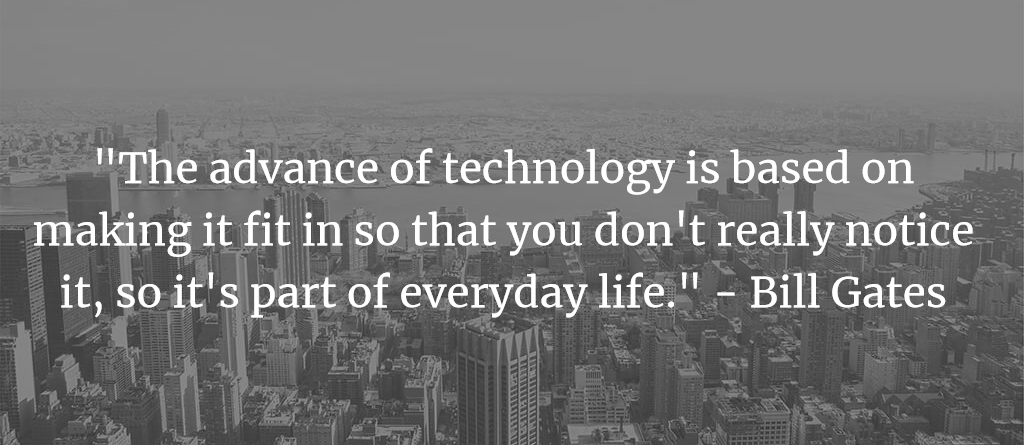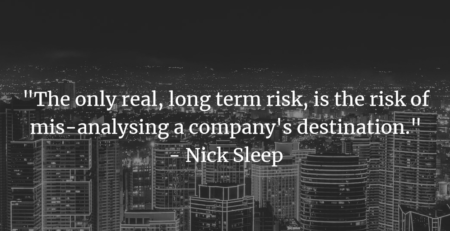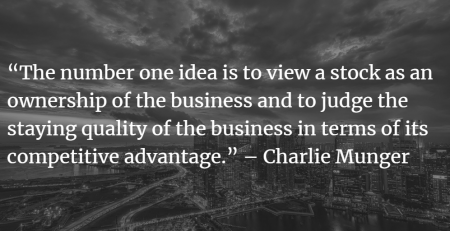Ocado (OCDDY): Automating the Really Difficult Stuff
We at Globescan mainly invest in US-based companies for fairly straightforward reasons: the regulatory environment is strong, the business environment friendly, there is a culture of entrepreneurship, and some of the most exciting companies in the world are US domiciled. That being said, there are occasions when we find companies overseas that offer something incredibly compelling that isn’t available here in the US, and it makes little sense to exclude such opportunities.
Ocado is one such opportunity – UK based, but listed here in the US and also trades via an ADR (American Depository Receipt). Ocado is an example of one of the most impressive and unique companies in the world today. It was started back in 2000 and has spent the last 21 years trying to perfect something that has only really become popular in the last couple of years – online grocery shopping and delivery. As we stand today, Ocado is already years ahead of the competition in this pursuit and will likely stay at the forefront of what is going to be a decades-long shift from traditional physical grocery shopping to the e-commerce channel (a shift that was recently kicked into overdrive by enforced COVID lockdowns).
At its core, Ocado is a technology company – but a technology company that started its life as a purely online UK supermarket. As you will have noticed, many grocers have been offering some version of “e-commerce” for years now (third-party delivery, in-store pick-up, etc), but crucially the vast majority of these grocers lose money on the business. Despite these losses, grocers must continue offering these online services to customers or otherwise risk losing a loyal customer. Since the industry as a whole barely generates low single-digit margins as is, adding a loss-making segment on top of that can create real issues. Consider that all existing grocers around the world have been trying at this for years, and so far all have failed to make the online experience sufficiently profitable: Tesco, Walmart, Sainsburys, Kroger, we could go on.
Even Amazon, a company with arguably infinite capital and some of the most impressive logistics and infrastructure in the world, entered this market and then pulled out again only a few years later as they could not make it work. We have also seen new third-party models recently pop up such as Instacart, but sadly these also fail to offer the end-to-end solution of a sufficiently profitable endeavor.
Yet Ocado, having spent 2 decades investing huge amounts into R&D to accomplish just that, now operates a purely online grocery business that has margins of almost 10%, and that should continue to expand towards 12%+. Compare that to your traditional supermarket of 2-5%, and you begin to see the opportunity. Any company that can enter a market the size of global grocery ($6-7trn) and quadruples the margins of the incumbents clearly has something worth investigating.
The Opportunity
Global food distribution is about a $6.7trn market, and this number grows fairly consistently with overall population growth and increases in spending power (low single digits). Online grocery is a small percentage today. There are a number of reasons:
- For grocery retailers it is either heavily margin dilutive or entirely loss-making, so they are reluctant to push it as a business, instead reluctantly offering it only because customers want it, and they can’t afford to lose otherwise loyal customers who will still occasionally shop in-store.
- Consumers in many countries (particularly the US) have had a poor experience with online grocery delivery so far as the proposition from retailers and other services like Instacart has been low quality: late deliveries, product substitutions, limited range, etc. This continues to the case today with many regions.
Whilst delivering groceries is very difficult for retailers, it provides an incredible value proposition for customers when someone like Ocado gets it right:
- Grocery orders are typically the same week after week. This lends them to automated ordering, pre-filled baskets, etc. AI can quickly work out what you order at certain times and make things very easy for you.
- Huge time savings: typical grocery trips are in excess of an hour – involving a drive, 15-30 minutes in-store, another drive, then unloading.
- Far greater variety: Ocado offers roughly 2x more product lines than most typical physical stores.
- No lack of availability issues in local stores (so fewer product substitutions).
- Easy menu and recipe preparation.
- Ability to add non-food items.
- Bulky, heavy items brought directly into your kitchen.
- Time slots that can be very precise (max one hour).
It is inconceivable that online grocery retailing does not grow substantially over the next decade given how well suited it is from a customer perspective. And COVID induced lockdowns have hugely accelerated this trend. In the last year alone, this is what happened to online grocery growth:
- US doubled to 10%
- UK doubled to 14%
- France +50% to 9%
- Sweden doubled to 5%
- Japan doubled to 5%
Now it is, of course, true that some of that shift was forced and some customers will return to physical stores (particularly as most non-Ocado online grocery is often not a great customer experience) but without doubt, the overall growth rate has accelerated. Many have tasted the convenience of online and will not go back to the store. We have already seen many of Ocado’s existing international partners increasing their CFC orders over the last twelve months, given the acceleration they’ve seen in customer demand.
Why is online grocery so hard to do?
The fact that so many others have tried and failed means we have to look carefully at why this is such a difficult thing to get right. There are three key reasons why food delivery is incredibly difficult to achieve efficiently and profitably:
- Perishability: Food goes bad, and quickly. Most items that Amazon sells can sit in a warehouse for months if necessary. When you are selling fresh fruits, vegetables, and meat, you have to be incredibly efficient with inventory management in order to both reduce waste (Ocado wastes less than 1% of food, vs 10% in the average US supermarket) and also to deliver fresh items to customers (some items may not be fresh even when ‘in date’).
- Temperatures: all warehouses, handling, and delivery must operate with 3 different temperature levels – ambient, chilled, and frozen. Products must be kept at the required temperature to ensure they are fresh and safe. This greatly adds to the complexity as each customer order will contain items from each of the three temperature ranges. They need to be stored, picked, and transported separately in their correct temperature zones.
- Basket size: the typical Amazon order contains a small number of items. The typical grocery order contains 50+ items. This results in an enormous increase in complexity when it comes to picking, order aggregation, and delivery.
So, to effectively do online grocery you have all the logistical challenges of an online retailer such as Amazon, but with three huge complications added on top. At the moment, most grocery retailers use one of three strategies to fulfill online grocery orders:
- In-store picking: someone goes around a store with a cart and loads an individual order (this could be an employee or a third-party provider such as Instacart). This is inefficient, capital intensive (you still need lots of large physical stores, employees, etc), and also disruptive. Retailers say that once this becomes more than 10% of store volume it is too disruptive to the customer experience, and they have to shift to the next stage.
- Dark store picking: to avoid disruption, retailers may operate an entire grocery store next to their real one, but one closed to the public where employees go to pick customers’ orders. Clearly, this adds greatly to the overall store costs, as you’re now effectively running two stores side by side.
- Customer Fulfilment Centers (CFCs): CFCs are large depots often built out of town to handle purely online orders. Some retailers have begun building out CFCs, but with nowhere near the level of automation or efficiency that Ocado can achieve.
By far the most common at this stage are either in-store picking or dark store picking. Both face significant issues:
- Limited inventory: stores can only carry so many products due to size limitations (varies per store). Ocado typically offers double the number of line items of a physical supermarket and at almost 100% availability.
- Labor intensity: stores are not the most efficient way to fulfill online customer orders, and still require people both stacking shelves and then the picking where employees are pushing carts around effectively ‘shopping’.
- Delivery: Once the order is picked, there is still the problem of getting the order to your customer’s house – an area that has proved incredibly tricky for many industries. Even more so when you incorporate the different temperature requirements of a food order. Something that many services like Instacart simply have to ignore, to the detriment of the customer experience.
- Capital intensity: traditional supermarket models require a huge number of stores across the country. Often expensive real estate, thousands of employees, etc. A fully hub/spoke CFC-led model such as Ocado’s is structurally far more efficient from a capital perspective- you can offer far more products at far higher availability to the same geographic area, but with a much lower capital outlay, and much lower ongoing cost.
Ocado the Company
The key to understanding Ocado is not that they are just a very efficient online grocer, but that they can take their already proven technology and sell it to other grocers.
A few years ago (around 15 years after the company was founded), Ocado CEO and founder Tim Steiner began to talk openly about the fact that their UK grocery business was in fact largely a beta testing facility and a proving ground for the underlying technology so that they could sell their solutions overseas.
In other words, Ocado built a $3bn+ UK online grocery business (that is still growing at 20%+) just to prove their technology could make online grocery profitable, an impressive feat. Once that had been proved beyond doubt, Ocado then began to license its technology – offering to operate the online service for other grocers globally. This was called the Ocado Solutions business, which sells/ licences/ operates the Ocado Smart Platform (OSP), their proprietary logistics technology. This is the exciting part of Ocado- yes, it’s a profitable online grocer in the UK, but more importantly, it is also a technology company that is enabling online grocery around the world, and it will get to share in that growth.
So, the ‘product’ Ocado is selling is effectively the Smart Platform – a modularised combination of hardware and software to enable online grocery for traditional supermarkets. Ocado licenses, installs, and operates the technology, and then they share in the ultimate revenue pass through. This is an incredibly scalable business model, and one where they face few legitimate competitors. As a result, in the last two years, Ocado has signed deals with grocers in Canada, US, Sweden, France, Australia, Japan, and the UK.
The Technology
Ocado currently operates four fully automated CFCs in the UK. Via their new overseas partnerships, they have agreements to build over 60 more of these globally (and this number keeps growing). The first of these global CFCs have only recently gone live, however, there is little need for concern about execution risk here- after all, Ocado have been this technology in their UK business for years. All they are doing is replicating that business in other geographies.
Ocado’s technology covers a few different areas and can manage the entire end-to-end delivery process for partners: order website, food inventory management, CFC warehouse, picking, delivery, etc. They own more than 200 patents directed to 60 separate innovations, leveraging a research and development team of over 1200. They cover AI, robotics, the cloud, big data, and the internet of things. Their CFCs are fully automated, utilizing their ‘hive’ technology of robots operating in a giant 3D grid.
The management of these robots, the inventory, and the necessary engineering associated with making all of this possible is incredibly difficult to replicate. Their picking systems are fully automated, with some of the most advanced robotics in the world. They are able to pick up delicate, oddly shaped items (like fruits and vegetables), test them for freshness, and then if suitable, load them carefully and gently into bags ready for delivery, and all whilst ensuring different temperature zones are adhered to throughout the picking and delivery process.
Existing efforts to operate grocery delivery just cannot come close to the level of efficiency of an Ocado CFC. Particularly when you consider that it would take multiple traditional physical stores and hundreds more employees to produce the same level of capacity as one single Ocado CFC.
What is the company worth?
We approach the valuation of Ocado as three elements. Firstly, there is the UK grocer (a joint venture with M&S), which is relatively easy to value as a standalone entity. Whilst it was developed as a proving ground for the technology, it’s still a company generating c$3bn in revenue, growing topline at 25%+ a year, and earning double digit operating margins. It is a substantial and valuable business in its own right.
Secondly, there is the international business through the OSP deals they have signed already. And thirdly are the future deals that are going to be signed in the future. A lot of the ultimate value of the OSP business is not yet reflected in the share price as this part of the company is much harder to value – most of the CFCs are not up and running yet, and Ocado does not provide much detail on the exact contract terms (for commercial reasons). To help understand the potential, the revenue model for this business is largely as follows:
- Initial sign-up/license fee: received in cash on agreement, recognized as revenue when first CFC begins operating.
- CFC Fees: this is a cash payment for the construction of each CFC.
- Fee-based on CFC capacity: They have never stated exactly what this is, and it will vary between deals, but the CEO has alluded to it being around 5%. Note: this fee is on capacity, not usage. Therefore, if Ocado builds capacity for a retailer, Ocado gets paid regardless of whether it’s fully utilized or not.
Typically, the capex for new CFCs is jointly funded by Ocado and the retailer, 1/3 Ocado, 2/3 retailer. (The company has stated that Kroger is an exception here, as they can finance so much more cheaply than Ocado and there are so many CFCs to be built, that Kroger will fund all of the capex for their 30+ CFCs).
The total cost per CFC is around £30m for £350m of capacity. The retailer typically builds and owns the building, buys the vans, and hires the drivers. Ocado owns, installs, and manages the robots and automation in the warehouse, as well as managing the entire software setup and delivery logistics.
Consider the network effects– the more partners they have, the better the overall system. This is in terms of data, algorithmic learnings, efficiency, and software. Software development is a key cost for Ocado, and by their admission is the biggest hurdle to growth right now. For each new partner, typically around 75% of the software is off the shelf, 15% is edited, and 10% has to be written from scratch. For some partners like Bon Preu (which is a franchise network, so every single area has different pricing) there is more software required from scratch. This is reflected in the fees Ocado charges the retailer.
The build-out of a CFC typically takes two years if a building is from scratch, or 18 months if they are retrofitting an existing building. The first of the international CFCs have recently gone live in the last 6 months. Note that the build-out of each CFC can be in tranches- e.g. the site may have an eventual capacity for £350m but the capacity could be built in multiple tranches. When it comes to capacity and future growth, we expect the operational CFC capacity to double for the next few years at least. That may sound aggressive, but in reality, it isn’t given their current build-outs underway.
Firstly- remember that Ocado gets paid an initial fee to set up each CFC, and then an ongoing fee based on the capacity of that CFC. Most retailers have exclusive rights to the technology in their region, but this exclusivity rests on them continuing to order a certain number of CFCs. If their growth in capacity slows, Ocado is free to sell to their competitors.
While this is clearly a wonderful situation for Ocado (basically they have contractual growth), it looks bad for the retailers at first glance- as they have to build out capacity regardless of whether it’s going to be used or not (a point many analysts mention as a significant negative). However, in reality, this simply isn’t going to be an issue- the amount of capacity already committed is tiny- less than 2% of overall sales right now. Most retailers are already fulfilling this or more via their traditional loss-making online channels anyway. There is huge capacity for growth here, and no cause for concern about capacity constraints for many years. Even though many of these contracts have only recently been signed, we’ve already seen many of the existing deals increase in size as retailers add more CFCs to their build-out plans for coming years given the huge spike in demand due to COVID.
When it comes to Ocado’s returns, due in part to the joint capex funding (or nil capex funding in the case of Kroger), the returns on capital that Ocado will generate in the future are substantial. However, given the company’s relatively small size and the huge scale of the contracts they have signed, from an Ocado perspective, they still stand at the beginning of a significant, multi-year capex cycle as the new CFCs are built out and brought online. In addition, the company continues to invest heavily in the platform and the technology- to ensure their competitive lead remains. Despite all of this investment, we can see a pathway from their current negative cash burn rates to turn positive in the next 2-3 years, followed by significant free cash flow expansion over the next decade.
And as with most technology companies today, Ocado is net cash. This gives them significant balance sheet comfort, as well as the capacity to continue their capex plans. As usual- the market is too short-term in its focus- looking too closely at the near-term capex and meager cash flow, and not giving this company for the incredible market they will be enabling over the next decade.
What is the risk?
Thinking about what could go wrong is always important. But the risks associated with rolling out the international CFCs are reasonably low. This is a modular system they have been operating in the UK for many years. The company themselves see the biggest risk as keeping pace with the necessary software integration/build-out for all of their new partners. That is likely to be the constraint to growth.
Now whilst the company has a significant technological lead at the moment, we have to be aware that may not last forever. There are a number of small players trying to do what Ocado is doing, but so far remain behind in both technology and capability. Were someone like Amazon aggressively re-enters this space, that would be something to watch closely. But based on their current grocery approach with Whole Foods and their current delivery ability they remain many years behind Ocado. Also, Amazon would likely be unable to partner with or offer their services to the existing grocery market ($12trn) as many retailers would understandably likely see Amazon as a competitor, rather than Ocado as a service provider and a means of defending their position or taking more share in their own markets.
There are always risks with any complex global system, particularly during the early year’s rollout phase. Should CFCs be delayed or canceled for any reason, that would be negative. The positive to that would be that if any retailer reduces its CFC orders it will lose its exclusivity in that region, allowing Ocado to offer its services to their competitors- it’s honestly hard to see how Ocado loses here.
In addition, Ocado has been making many other investments into robotics to improve its technology lead further, into vertical farming to improve its supply chain efficiency, and even technology to allow same-hour grocery delivery in some markets such as London (it is already operational and profitable there). There are also other opportunities for the Ocado technology outside of grocery – arguably Ocado is the most advanced logistics company on the planet, and its technology could be applied to many other industries besides grocery. The company’s technology arm even operates with the tagline “changing the way the world stores, sorts, and moves atoms”- deliberately broad.
Conclusion
Overall, in Ocado, we are presented with a unique company at the forefront of an incredible multi-year trend. Not only that, but because this industry is so nascent, we are able to acquire the company for much less than its ultimate intrinsic value. This is a company with unique technology and the benefit of long-term contracts locking in huge growth with some of the world’s largest companies.
Ocado is going to be able to grow its top line comfortably in excess of 25%, with net income growing even faster. And it remains likely that we will continue to see contract expansions, new OSP partners, and even new business or industry opportunities. The opportunity here really is vast.
Disclosures: This website is for informational purposes only and does not constitute an offer to provide advisory or other services by Globescan in any jurisdiction in which such offer would be unlawful under the securities laws of such jurisdiction. The information contained on this website should not be construed as financial or investment advice on any subject matter and statements contained herein are the opinions of Globescan and are not to be construed as guarantees, warranties or predictions of future events, portfolio allocations, portfolio results, investment returns, or other outcomes. Viewers of this website should not assume that all recommendations will be profitable, or that future investment and/or portfolio performance will be profitable or favorable. Globescan expressly disclaims all liability in respect to actions taken based on any or all of the information on this website.
There are links to third-party websites on the internet contained in this website. We provide these links because we believe these websites contain information that might be useful, interesting and or helpful to your professional activities. Globescan has no affiliation or agreement with any linked website. The fact that we provide links to these websites does not mean that we endorse the owner or operator of the respective website or any products or services offered through these sites. We cannot and do not review or endorse or approve the information in these websites, nor does Globescan warrant that a linked site will be free of computer viruses or other harmful code that can impact your computer or other web-access device. The linked sites are not under the control of Globescan, and we are not responsible for the contents of any linked site or any link contained in a linked site. By using this web site to search for or link to another site, you agree and understand that such use is at your own risk.






